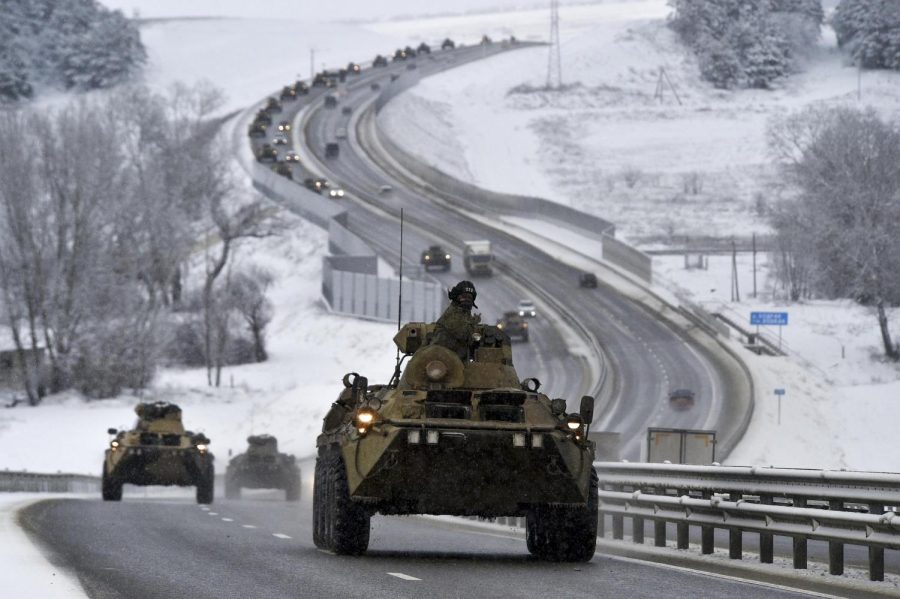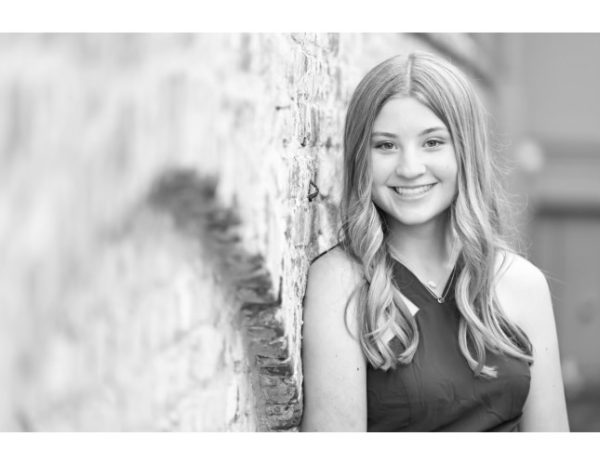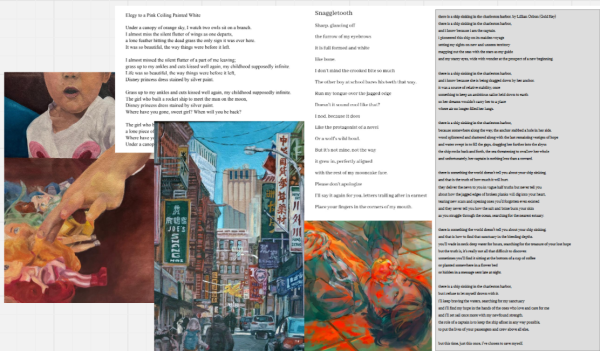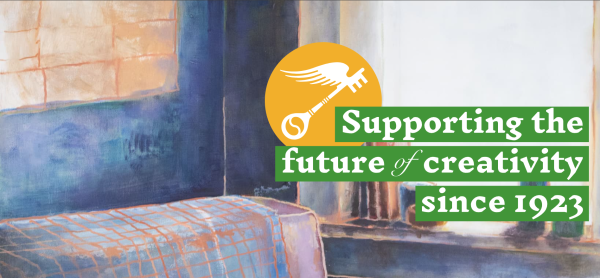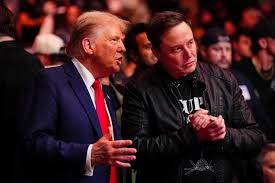What is going on in Ukraine?
A Brief Summary of the Russia-Ukraine Conflict
Russia and Ukraine have a long history, much of it somewhat friendly, and yet over the past few months the tensions seem to be constantly rising. As intelligence reports and satellite imaging show an increase of Russian troops along the Ukraine border, Ukraine has responded with an increase of military presence, and other countries seem ready for a war or invasion. In this article I will be giving some background on the how the conflict started, and the current state of it.
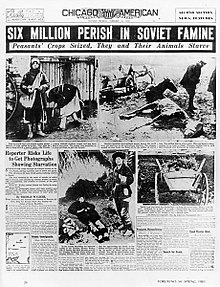
The first major link between Russia and Ukraine was in the 9th century, when a group called the Rus, ancestors of modern day Russians and Ukrainians, moved their capital to Kiev, the capital of Ukraine. After the Mongols invaded the Rus in the 13th century, the Ukrainians and Russians path’s diverged for a while, until Ukraine sought union with Russia in the 17th century because of unrest with the Polish controlled Ukrainian commonwealth. Up until the end of War World I, most Ukrainians considered themselves ethnically Russian and this was furthered by Russiafication programs in the 19th century where Ukrainian language was banned from schools. Ukraine and Russia were two of the founding members of the USSR, and this brought the end of the ban on Ukrainian language, and started a period of celebration of each countries’ individual culture. Between 1932 and 1933 up to 7.5 million Ukrainians died from famine, which is often considered partly man made through poor policy and confiscation of food items. This is now commonly referred to as the Famine-Genocide in Ukraine. In 1991, Ukraine gained their independence, but their long history together is often used by Putin and Russia as a defense for why these countries are bound together.
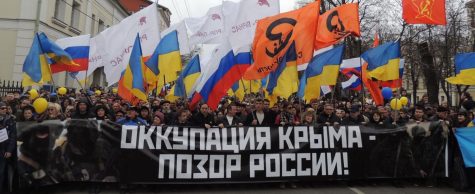
Between 1991 and 2014, relationships between Russia and Ukraine waxed and waned as various presidents were voted into office in Ukraine. In 2014, relationships took a wild turn as their Pro-Russian president rejected an agreement for greater involvement and integration into the European Union. This caused mass protests that were met by violence from the government. After the president was ousted, Russia, worried that they would lose their influence, used the confusion to invade and annex Crimea, a Ukrainian peninsula. In the next few months Pro-Russia separatists started to seize territory in Russia, although the rebels eventually lost, Russia invaded eastern Ukraine to support them, and over 2,500 Ukrainians were killed. Ukraine’s Supreme Court called the annexation, “a gross violation of international law,” and although sanctions were introduced by Ukraine, no extreme action was taken, and Russia still is in control of Crimea.
As relationships between Russia and Ukraine have soured, Ukrainian support for joining NATO,(North Atlantic Treaty Organization) and NATO support for Ukraine has increased. Because of this, Russia is worried that western nations’ influence will dramatically increase in the region if Ukraine joins NATO, and seems strongly opposed to this. Russia so far claims that the U.S. and other NATO members are already providing weapons and military personnel to Ukraine, which they claim are further aggravating the border situation. Putin also has said that if Ukraine joins NATO the alliance might try to recapture Crimea. The NATO nations have told Russia that they can not dictate whether Ukraine joins NATO or not, but worryingly Russia’s foreign prime minister, Sergey Lavrov stated that, “we cite a clause of international law, which stipulates that each state has the right to choose methods of ensuring its legitimate security interests,” regarding the possibility of Ukraine joining the organization. Additionally, Ukraine might be desired by Russia because of its access to warm water ports through the Black Sea, which is a commonly thought reason for why they annexed the Crimean peninsula in the first place.
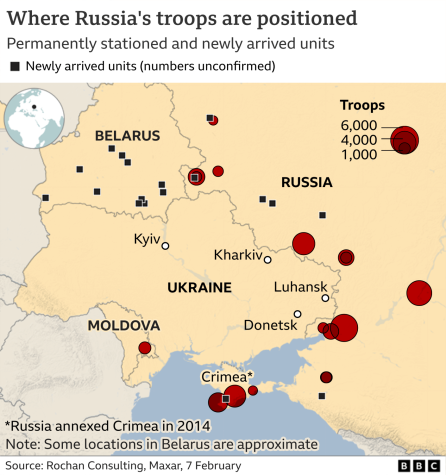
So what exactly is going on at the border right now? In recent weeks, Russia has significantly built up their military presence around the border, with over 130,000 troops currently around the border, surrounding Ukraine on three sides. U.S. Intelligence claims that their forces would need to reach around 175,000 before they launch an invasion, but there are around 15,000 separatists fighters already in Ukraine, and Russia has over 3 million total fighters at their disposal. In recent days, Belarus, one of Russia’s closest allies have also been increasing their military presence on the border, much of it Russian. Russia and Belarus have said that they will be holding joint military drills from February 10th to the 20th in order to train to repel an attack on the Belarusian border. However, this is disturbing at a time when tensions are so high, and many think this could just be further military advancement for the possible invasion. Satellite images show that this Belarusian buildup includes missiles, rocket launchers, and attack aircrafts, in what the Nato Chief called, “the biggest Russian Deployment there since the Cold War.” Additionally 6 Russian warships are heading to the Black Sea, just under Ukraine, for these same military drills.
Russia has not only been building up its military presence, it has made numerous other moves that seem like they are prepared for war. The U.S. has found information that Russia could start a false flag operation in Ukraine, in which an act is committed to shift the blame away. In this case, the U.S. warned of a possibility of trained operatives that would attack their own Russian forces in order to claim Ukraine had attacked them, and justify a full on invasion of Ukraine. More recent U.S. intelligence found that Russia could be creating propaganda videos with actors, with one possibility showing the graphic aftermath of a “Ukrainian” explosion targeting the Russian people. One more card in the Russian’s hand was their mass hand outs of Russian passports in eastern Ukraine. As of last May, over half a million passports had been issued, and many think this could be so Russia can claim they are defending their own citizen’s interests if they decide to invade.
While things seem dark, there is still hope. France’s president, Macron, recently had talks with Putin and is urging people to stay calm. Macron in this meeting said that Putin assured him he would not be the one escalate the conflict. Either way, let’s hope for peace. I think we can all agree that the already devastating 2020’s do not need a World War.



